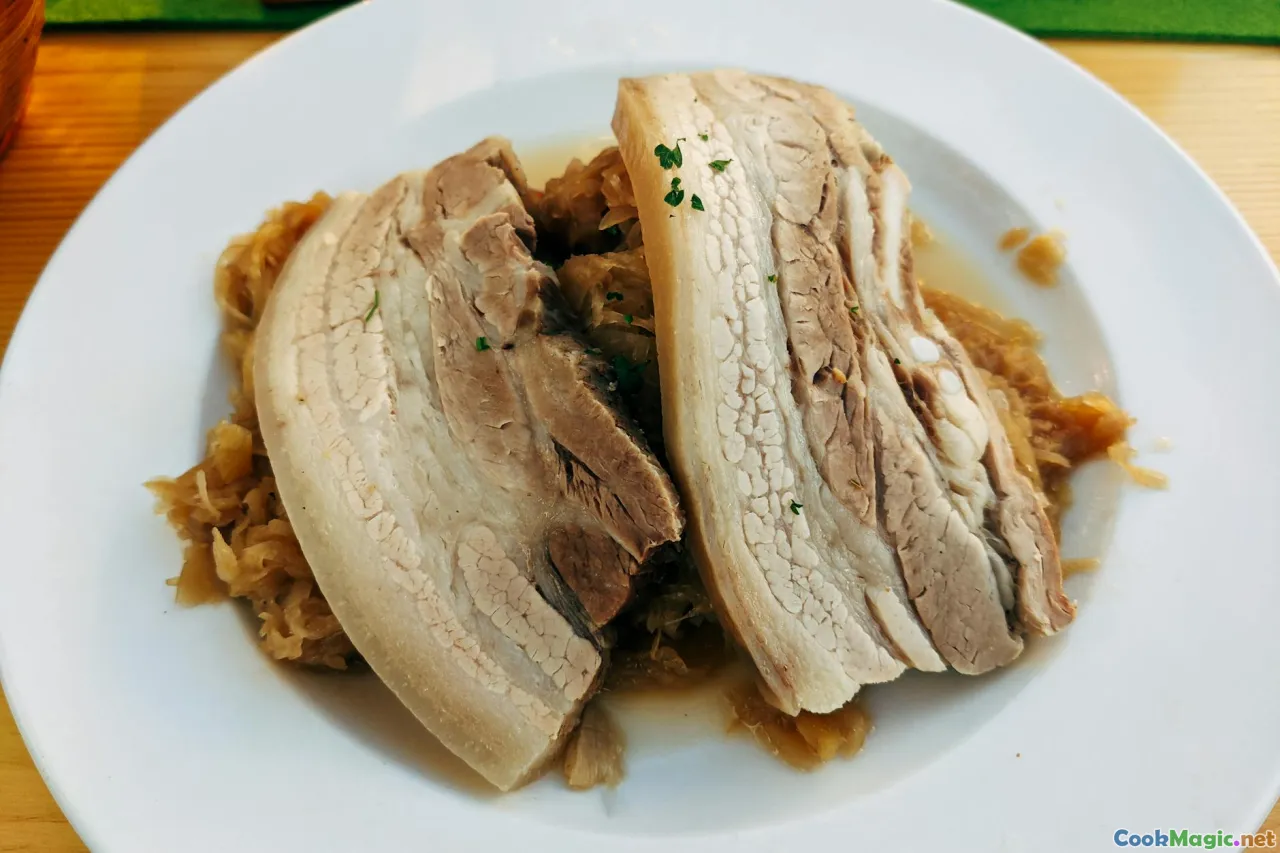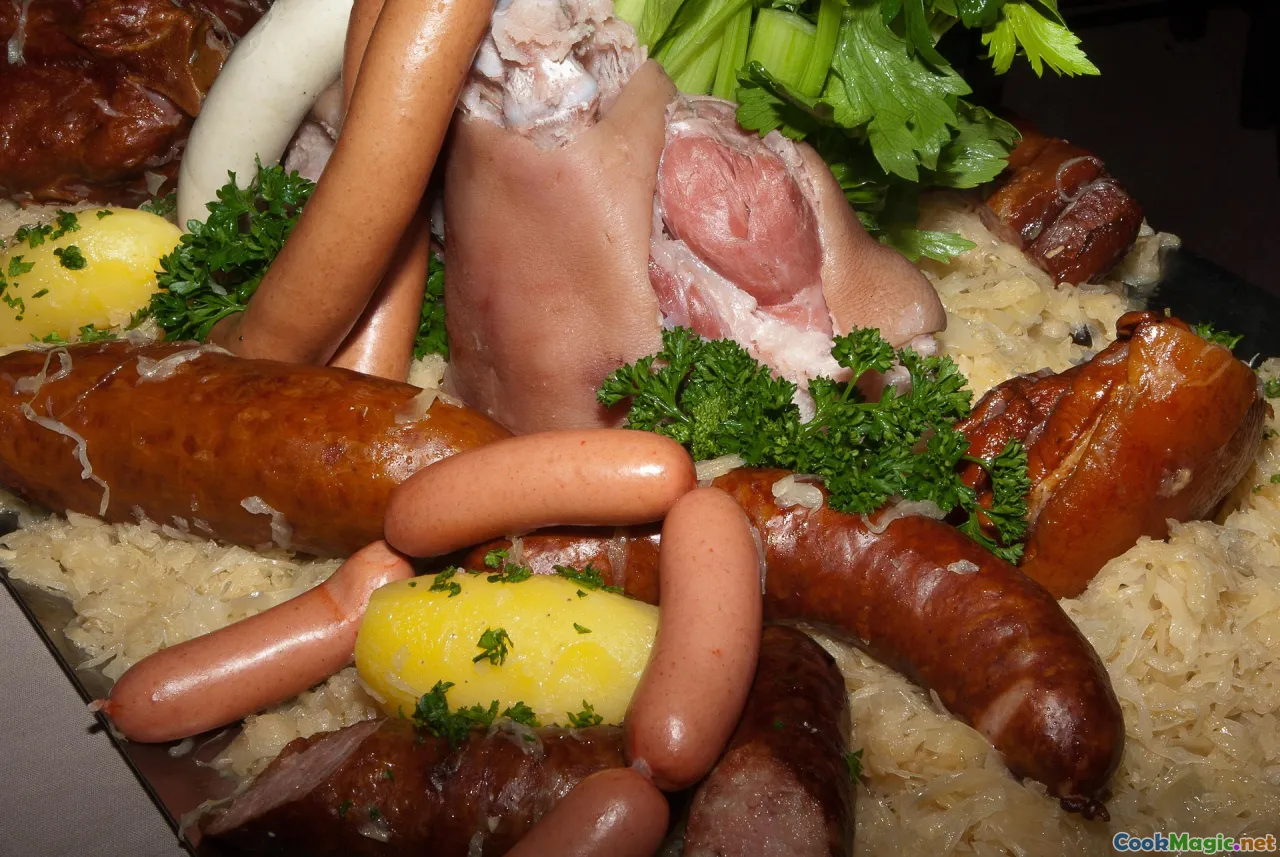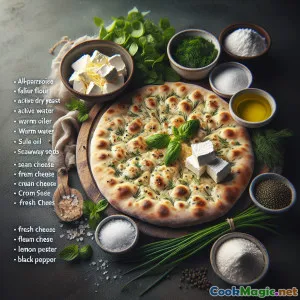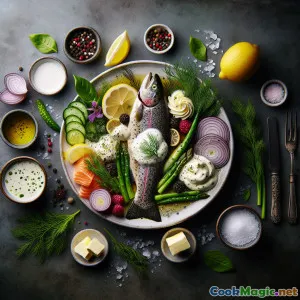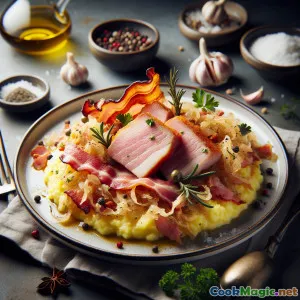
Polenta trong chảo với dưa cải chua và thịt heo Zasavje
(Zasavje Sauerkraut Pork Polenta Skillet)
(0 Đánh giá)0
317
tháng 11 01, 2025
Báo cáo sự cố
Nguyên liệu
-
600 grams Thịt vai heo, đã lọc bỏ mỡ và cắt thành miếng vuông nhỏ
(Well-marbled cuts stay juicy during braising.)
-
80 grams Bacon hun khói hoặc pancetta, cắt nhỏ
(Adds depth and smokiness; omit for lighter version.)
-
600 grams Dưa cải bắp lên men, đã ráo nước và rửa nhẹ
(Rinse briefly if very sour; squeeze out excess brine.)
-
1 large Hành tây, băm nhỏ
(Yellow onion preferred for sweetness.)
-
3 cloves Tỏi (băm nhỏ)
(Điều chỉnh theo khẩu vị.)
-
2 tbsp Mỡ lợn hoặc dầu ăn trung tính
(Lard is traditional; oil works well.)
-
1 tsp Hạt thì là nghiền nhẹ
(Signature spice with kraut; don’t skip.)
-
1 tsp Ớt paprika ngọt
(Adds warmth and color.)
-
2 leaves Lá nguyệt quế
(Remove before serving.)
-
4 Berries Quả bách xù, nghiền nhẹ
(Traditional with cabbage; piney aroma.)
-
120 ml Rượu vang trắng khô hoặc cider táo
(Deglazes and brightens the stew.)
-
500 ml Nước dùng gà hoặc nước lọc
(Enough to just cover pork and kraut.)
-
1 tsp muối biển mịn
(Adjust; sauerkraut and bacon add salt.)
-
0.5 tsp Tiêu đen xay mới
(Nếm thử.)
-
240 grams Polenta thô (bột ngô)
(Coarse grind for rustic texture.)
-
900 ml Nước hoặc nước dùng nhẹ (dành cho polenta)
(Adjust for desired thickness.)
-
200 ml Sữa nguyên kem
(Enriches polenta; use more water for dairy-free.)
-
40 grams Bơ
(For creamy finish.)
-
80 grams Kem chua
(Swirl into polenta or dollop on top.)
-
1 small Táo chua, bào sợi
(Balances sauerkraut with subtle sweetness.)
-
2 tbsp Ngò tây lá phẳng, băm nhỏ
(Fresh herbal finish.)
(Well-marbled cuts stay juicy during braising.)
(Adds depth and smokiness; omit for lighter version.)
(Rinse briefly if very sour; squeeze out excess brine.)
(Yellow onion preferred for sweetness.)
(Điều chỉnh theo khẩu vị.)
(Lard is traditional; oil works well.)
(Signature spice with kraut; don’t skip.)
(Adds warmth and color.)
(Remove before serving.)
(Traditional with cabbage; piney aroma.)
(Deglazes and brightens the stew.)
(Enough to just cover pork and kraut.)
(Adjust; sauerkraut and bacon add salt.)
(Nếm thử.)
(Coarse grind for rustic texture.)
(Adjust for desired thickness.)
(Enriches polenta; use more water for dairy-free.)
(For creamy finish.)
(Swirl into polenta or dollop on top.)
(Balances sauerkraut with subtle sweetness.)
(Fresh herbal finish.)
Dinh dưỡng
- Khẩu phần: 4
- Kích thước khẩu phần: 1 bát (350g)
- Calories: 690 kcal
- Carbohydrates: 0 g
- Protein: 33 g
- Fat: 32 g
- Fiber: 8 g
- Sugar: 6 g
- Sodium: 1350 mg
- Cholesterol: 95 mg
- Calcium: 120 mg
- Iron: 3.8 mg
Hướng dẫn
-
1 - Prep the aromatics and kraut:
Chop onion, mince garlic, and lightly crush caraway and juniper. Drain sauerkraut, rinse briefly if very sour, and squeeze dry to prevent a watery stew.
-
2 - Brown the Pork:
Heat lard in a heavy pot over medium-high. Pat pork dry and sear in batches until well browned. Transfer to a plate; keep fond in the pot.
-
3 - Render bacon and sauté onion:
Lower heat to medium. Cook bacon until some fat renders, then add onion and a pinch of salt. Cook until translucent and lightly golden.
-
4 - Bloom spices and garlic:
Stir in garlic, caraway, and paprika. Cook 30–45 seconds until fragrant, stirring to avoid scorching.
-
5 - Deglaze and build the braise:
Pour in white wine, scraping up browned bits. Return pork with any juices, add sauerkraut, bay leaves, and juniper. Stir to combine.
-
6 - Simmer Gently:
Add stock to just cover. Bring to a gentle simmer, cover partially, and cook until pork is tender. Stir occasionally; add a splash of water if needed.
-
7 - Start the polenta:
Bring water (and milk if using) to a low boil in a saucepan. Rain in polenta while whisking. Reduce to low and stir frequently until thick and creamy.
-
8 - Finish polenta:
Stir in butter and a pinch of salt. Adjust consistency with hot water. Optionally fold in sour cream for extra richness.
-
9 - Season the pork and kraut:
Taste the stew. Add pepper and salt only if needed—sauerkraut and bacon contribute salinity. Remove bay leaves (and juniper if used).
-
10 - Serve and Garnish:
Spoon creamy polenta into warm bowls, top with sauerkraut-pork mixture. Garnish with grated apple and parsley for brightness.
Chop onion, mince garlic, and lightly crush caraway and juniper. Drain sauerkraut, rinse briefly if very sour, and squeeze dry to prevent a watery stew.
Heat lard in a heavy pot over medium-high. Pat pork dry and sear in batches until well browned. Transfer to a plate; keep fond in the pot.
Lower heat to medium. Cook bacon until some fat renders, then add onion and a pinch of salt. Cook until translucent and lightly golden.
Stir in garlic, caraway, and paprika. Cook 30–45 seconds until fragrant, stirring to avoid scorching.
Pour in white wine, scraping up browned bits. Return pork with any juices, add sauerkraut, bay leaves, and juniper. Stir to combine.
Add stock to just cover. Bring to a gentle simmer, cover partially, and cook until pork is tender. Stir occasionally; add a splash of water if needed.
Bring water (and milk if using) to a low boil in a saucepan. Rain in polenta while whisking. Reduce to low and stir frequently until thick and creamy.
Stir in butter and a pinch of salt. Adjust consistency with hot water. Optionally fold in sour cream for extra richness.
Taste the stew. Add pepper and salt only if needed—sauerkraut and bacon contribute salinity. Remove bay leaves (and juniper if used).
Spoon creamy polenta into warm bowls, top with sauerkraut-pork mixture. Garnish with grated apple and parsley for brightness.
Thông tin thêm về: Polenta trong chảo với dưa cải chua và thịt heo Zasavje
Zasavje Sauerkraut and Pork Polenta
This dish unites two iconic Central European comforts—braised pork with sauerkraut and slow-stirred polenta—into a deeply satisfying bowl that’s both rustic and refined. Hailing in spirit from Slovenia’s Zasavje region, where hardworking mining and industrial communities favored hearty, sustaining meals, it captures the balance of tangy fermented cabbage, tender pork, and the mellow, buttery cushion of cornmeal. Think of it as a meeting between a cozy alpine stew and a Central European staple, tailor-made for chilly evenings and convivial tables.
Why it Works
- Sauerkraut provides brightness that cuts through the richness of pork. Its lactic tang adds complexity without needing heavy seasoning.
- Caraway, bay, and optional juniper echo traditional Slovenian flavors that pair naturally with cabbage.
- A gentle braise coaxes collagen from pork shoulder, yielding spoon-tender bites that mingle with kraut juices.
- Polenta, finished with butter (and optional sour cream), offers a creamy, neutral counterpart that soaks up savory braising liquid like a dream.
Ingredient Notes
- Pork shoulder: Choose a cut with visible marbling. Leaner cuts risk dryness; shoulder stays succulent during a 40–60 minute simmer.
- Sauerkraut: Use a live-fermented kraut if possible. A brief rinse controls acidity; don’t rinse excessively or you’ll lose character. Squeezing out brine avoids a watery stew.
- Caraway and juniper: Classic with cabbage in Slovenia and neighboring cuisines. Juniper is optional but adds a foresty lift reminiscent of alpine cooking.
- Liquids: White wine brightens; apple cider gives a soft fruitiness. Stock enriches the braise without overpowering the kraut.
- Polenta: Coarse cornmeal yields rustic texture; finer grinds cook faster but can turn gluey if overworked. Stir frequently and finish over low heat.
Technique Tips
- Searing matters: Well-browned pork builds a caramelized base. Work in batches and don’t crowd the pot, or you’ll steam the meat.
- Bloom spices: Briefly toasting paprika and caraway in fat wakes up their aromas. Keep it short—30 to 45 seconds—to prevent bitterness.
- Simmer, don’t boil: A gentle bubble keeps pork tender and sauerkraut pleasantly toothsome.
- Polenta patience: Add cornmeal in a slow rain while whisking to avoid lumps. Switch to a wooden spoon as it thickens; scrape the pan bottom so it doesn’t stick.
Make-Ahead & Storage
- The sauerkraut-pork braise improves overnight as flavors meld. Chill quickly and store up to 3 days.
- Reheat gently with a splash of stock or water.
- Polenta firms as it cools. Reheat with hot water or milk, whisking to restore creaminess. Leftover firm polenta can be sliced and pan-fried for tomorrow’s breakfast.
Substitutions & Variations
- Meat: Use smoked sausage or ham hock in place of bacon for bigger smokiness. For poultry, try boneless chicken thighs (reduce simmer time).
- Dairy-free: Skip milk and butter; finish polenta with olive oil.
- Extra veg: Stir in shredded savoy cabbage or grated carrot during the last 10 minutes of the braise for sweetness and color.
- Zesty finish: A spoon of prepared horseradish or mustard at the table adds punch.
- Herb swap: Dill can replace parsley for a brighter herbal note.
Serving Suggestions
- Pair with a crisp, dry white wine (Sauvignon Blanc, Furmint, or local Slovenian whites) or a malty lager.
- Offer rye bread on the side to mop up juices.
- Top each bowl with a small mound of grated tart apple—it plays beautifully against the kraut and smoky pork.
Cultural Snapshot
Polenta (known locally as koruzna polenta or žganci depending on style) is embedded in Slovenian culinary tradition, especially in regions where corn cultivation took hold. Zasavje, historically a coal-mining heartland, developed a no-nonsense food culture that favored robust flavors, preserved ingredients, and dishes that could sustain long working days. Sauerkraut, a staple of the winter larder, offered vital nutrients and bright flavor when fresh produce was scarce. Combining kraut and pork with polenta reflects this practical, seasonal approach, bridging mountain and valley traditions common across Slovenia and its Central European neighbors.
Unique Touches
- The optional grated apple garnish is a small but transformative flourish, adding a fresh aromatic sweetness that lightens each spoonful.
- Juniper berries, though subtle, underscore the forested character of the region and complement the fermented tang of kraut.
- Part wine, part stock braising builds layers of flavor without heaviness, letting the kraut remain the star.
Troubleshooting
- Too sour? Stir in a knob of butter or a splash of cider; sweetness and fat round sharp edges.
- Too salty? Add a handful of shredded raw cabbage and a splash of water, then simmer 5–10 minutes.
- Polenta too thick? Whisk in hot water in small increments until it loosens to a soft mound.
With simple ingredients and careful attention to texture and balance, Zasavje Sauerkraut and Pork Polenta transforms pantry staples into a soulful centerpiece—one that feels both time-honored and fresh at your table.

